
 |
Drug Intelligence BriefHEROIN TRAFFICKING
IN RUSSIA'S TROUBLED EAST
|
|||||
 Scoring heroin poppy |
Russia’s Siberian Federal District (Siberia) and the Far Eastern Federal District (the Russian Far East, or RFE) have experienced a surge in heroin trafficking and abuse over the past several years. The reasons for the increase are complex, but the combination of increased Afghan heroin production, increased trafficking via the Silk Road in Central Asia, weak border controls, and a diminished Russian economy has fueled traffic into areas of Russia that had never experienced heroin on such a large scale. According to Antonio Maria Costa, Executive Director, United Nations (U.N.) Office of Drugs and Crime, only 1 percent of Russian drug abusers used heroin in 1996; today, nearly 30 percent of drug users abuse heroin. Only Laos, Tajikistan, and Iran have higher opiate-abuse rates.
The economic and social impact of heroin abuse and trafficking in Russia are substantial. Russian officials estimate that half of the heroin transiting Russia is intended for European markets, while the remainder is targeted for domestic use in Russia. Although the impact of this heroin trafficking in Siberia and the RFE on the United States is less dramatic, the potential for harm is great because Russia’s Pacific seaports are controlled by powerful organized crime groups. As Central Asian traffickers establish themselves more in eastern Russia, the opportunity exists to collude with Russian crime bosses to export heroin to the more lucrative markets of the Pacific Rim 1 and the United States.
BACKGROUND
Siberia and the RFE, districts that have been traditionally ignored by Russia’s Moscow-based Central Government, are now receiving attention from Russian officials, who have noted an unprecedented spike in heroin traffic and abuse in the two regions. As little as 3 years ago, the most significant drugs of concern in Siberia and the RFE were opium, hashish, poppy straw, and ephedrine. Today, while abuse and trafficking of these drugs are still significant, they are overshadowed by bulk seizures of Afghan heroin and epidemic rates of heroin addiction. Russian President Vladimir Putin labeled drugs a national security concern, stating that the drug trade in Russia funds terrorist organizations, spurs illegal migration, facilitates arms trafficking, and causes a collapse in overall living standards.
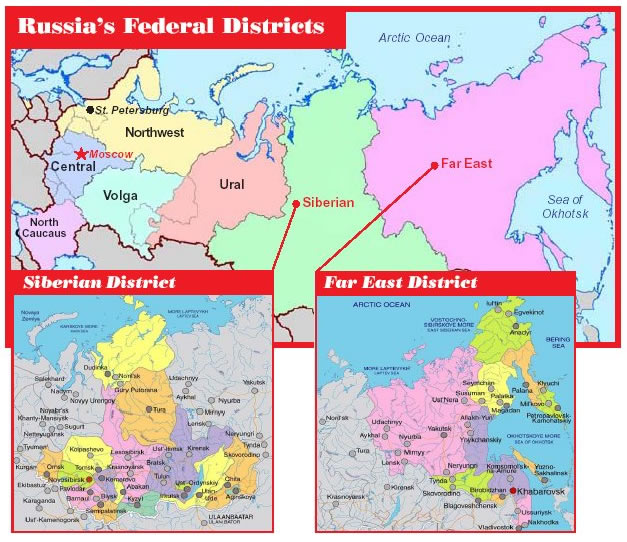
The problems in Siberia and the RFE are not as isolated as they may seem. It is important that not only the Russian Government, but also neighboring countries and the world community as a whole should be concerned about their problems. Drug addiction is closely linked to the rise in crime and disease, which, in turn, damages economies and social stability, and impairs government legitimacy. A crisis grows as an increase in the heroin flow fosters a surge in addiction, Acquired Immune Deficiency Syndrome (AIDS), and unemployment in an area where democratic and free market institutions are still developing. Regional instability caused by a collapsed economy, as well as rampant crime and corruption, could directly affect China, Japan, South Korea, and the United States, as these countries open trade with Siberia and the RFE.
Siberia and the RFE are already causing strategic security concerns for the Russian Government. During a November 2002 meeting of the Russian Security Council, President Putin labeled the RFE the most crisis-ridden district of Russia, where drugs and drug-related crime have compounded the problems already caused by poverty and corruption. The rise of drug traffic and domestic demand in Siberia and the RFE can be attributed to:
AFGHANISTAN’S BUMPER OPIUM CROP AND HEROIN STOCKPILES
Afghanistan has historically been a source country for opiates. Following the withdrawal of the Soviet Army in 1989, the ensuing civil war decimated the Afghan economy. By the time the Taliban took control in 1995, opium was the country’s most profitable cash crop, with Afghanistan producing nearly 35 percent of the world’s opium. Within 5 years, spurred on by Taliban complicity, producers cultivated nearly 72 percent of the world’s opium (3,656 metric tons). As the heroin supply grew, its market value plummeted. Despite the Taliban’s self-serving ban on opium production in 2000, enormous stockpiles of cheap opium and heroin remained from previous seasons’ harvests. It was this heroin that flooded the Russian market after 2000 and 2001.
The price of heroin in Russia dropped dramatically. Whereas, in 1993, a gram of heroin averaged US$200, the price fell to US$170 by 1995, and US$60 by 1999. In early 2001, it was down to between US$25 and US$30. Although it is now possible to find low-quality heroin for US$10 per gram in Russia, prices generally hover around US$40, and are even lower in Siberia. Open-source reporting states that heroin in Omsk is between 700 and 1,000 rubles (between US$23 and US$33 per gram). This cheap heroin fuels addiction in even the most remote areas of the country, such as in Norilsk, an isolated mining city in northern Siberia with a population of only 165,000. In January 2003, a seizure of 25 kilograms of heroin could have provided 5 million dosages.
A CRACKDOWN ON THE IRANIAN BORDER AND THE BALKAN ROUTE
As the Taliban consolidated their control in Afghanistan, the Iranian Government took steps to fortify its eastern border. Iran built new border checkpoints and spent nearly US$1 billion to improve security against traffickers smuggling opiates westward. In response, some traffickers sought other routes to Turkey and Western Europe. The weak southern borders in Central Asia and Russia were an attractive alternative.
Drug trafficking organizations, based in Turkey, have faced increased law enforcement activities on the infamous Balkan Route since 2001. A new Drug Enforcement Administration (DEA) project, called Operation Containment, coordinates law enforcement efforts of the United States and its regional partners, through the Southeast European Cooperative Initiative (SECI), 2 to stem the flow of Afghan heroin to the markets of Europe and Asia. Although the Balkan Route is perceived as the greater heroin threat for Europe, Afghan and Central Asian traffickers find it easier to smuggle heroin via the Silk Road and Northern Route into Russia for further transit to Western Europe.
A FALTERING ECONOMY AND DWINDLING POPULATION
Eastern Russia has seemingly boundless quantities of petroleum reserves, precious metals, minerals, timber, fish, and other raw materials. This natural wealth has led analysts to believe that after the 1991 breakup of the Soviet Union, eastern Russia would develop faster economically than western Russia. This has not been the case because the area’s vastness, low population, and lack of viable infrastructure have hindered development.
Although Siberia and the RFE cover 66 percent of Russian territory (nearly 14 million square kilometers), the districts have an average population density of only 1.9 people per square kilometer (a population of nearly 26.6 million). 3 In addition, the continuing economic depression has caused the population to decrease further, a result of a low birth rate, a “brain drain,” and massive migration to western Russia. According to statements by the Russian Government, the RFE lost almost 20 percent of its population between 1991 and 2001 (about 1.5 million people).
The high cost of living and unemployment in Siberia and the RFE add to the economic misery. Vast distances between cities and extreme weather conditions result in high transportation costs for the delivery of consumer goods and services. The region’s high oil and gas tariffs make energy costs twice as expensive as the rest of Russia. Secure employment in eastern Russia’s heavily defense-oriented, economy vanished for much of the population after the peace initiatives and 1990’s subsidies cuts significantly drove down military-industrial production. Economic analysts state that the unemployment rate in the most hard-pressed areas of Russia (including northern Siberia and the RFE) can fluctuate between 15 and 40 percent, mostly due to the fact that severe weather conditions make many jobs seasonal. Even during high season, these rates are much higher than Russia’s official unemployment rate of 8.9 percent (unofficially, Russia’s average unemployment rate has been estimated as high as 25 percent).
Siberia and the RFE are prime examples of how troubled economic conditions are linked to a surge in alcohol and drug abuse. The Russian Ministry of Health reports that, since the breakup of the Soviet Union, the number of drug addicts in Russia increased 12 fold, to 3 million by early 2003. 4 Russian officials estimate that now almost half the heroin entering the country is for domestic consumption. In the RFE, addiction rates have been particularly devastating. Russian experts informed the DEA Moscow Country Office that some isolated cities are facing 50-percent-alcohol- and 30-percent-drug-addiction rates. The availability of cheap heroin in eastern Russia drives demand as more people become addicted. The negative effects that such high levels of abuse will play on the already depressed economy, in terms of mortality, lost work, illness, and crime, are bound to be substantial.
An AIDS crisis, the result of intravenous drug use and a lack of preventative education, is further decimating the region. The Russian Federal AIDS Center reports that, as of May 2003, there were nearly 240,000 registered Human Immunodeficiency Virus (HIV)-infected people in the country. Unofficially, the center estimates that the number could be as high as 1.5 million. In areas of the RFE, infection rates closely mirror those in sub-Saharan Africa. Irkutsk (central Siberia) has Russia’s highest number of registered AIDS patients (7,800 patients, or 1 out of 70 citizens), followed by Kaliningrad, Moscow, and St. Petersburg. In September 2001, a Maritime District AIDS center stated that there were 2,600 HIV infections. By May 2002, that figure rose to 3,500, and by November 2002 there were 4,075 cases. There are fears of a major epidemic in Krasnoyarsk, where estimates state that there could be 45,000 victims by 2005. Today, the Russian AIDS Center states that 1 percent of the populations of the isolated cities of Togliatti, Orenburg, and Norilsk are infected with HIV.
RUSSIAN ORGANIZED CRIME IN THE EAST
Another factor affecting drug traffic is Russian organized crime (ROC). Although criminal networks were firmly entrenched in the RFE during the Soviet period, the corrupt post-Soviet society has been conducive for ROC to step up their activity. ROC now controls all aspects of the maritime, tourism, automotive, mining, and fishing industries in the RFE. Media sources report that over 149 organized criminal groups operate there, 40 of which have international connections. In the Maritime Region, also called Primoriye, whose capital is Vladivostok, these groups use bribery, extortion, and violence to influence politics and gain favors. Local politicians and businessmen have been both the perpetrators and victims of these crimes. In May 2002, General Vitaly Gamov, Deputy Director of the Pacific Department, Russian Federal Border Service, and his wife were killed in Yuzhno-Sakhalinsk, when three Molotov cocktails were thrown into their apartment. Gamov had been trying to combat organized criminal involvement in fish poaching. In November 2002, businessman Viktor Aksinin also was murdered in Nakhodka in connection with his crackdown on poaching.
The Russian Drug Control Department (DCD) suspects that ROC groups in South America use ports in eastern Russia to import multiton shipments of cocaine, synthetic drugs, and precursor chemicals into the RFE. ROC already takes dvantage of their control of the port in St. Petersburg to import cocaine. In 1997, the Medvedkovskaya OC group was linked to a 204-kilogram cocaine seizure in Bratsk (south-central Siberia). The cocaine was actually imported into St. Petersburg concealed in a shipment of canned pineapples. This group attempted to use Siberia as a transit point for the cocaine to Europe, reasoning that Russian Customs officials would not suspect a shipment originating from South America because there is no cocaine market in Siberia.
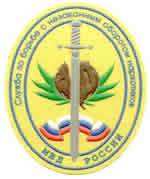 Russian Drug Control Department |
ROC has full control of Russia’s eastern ports and is well positioned to operate international drug shipments. DEA Moscow Country Office sources report that Latin American trafficking groups have explored the idea of sending cocaine-laden vessels to points off the shore of Vladivostok to rendezvous with fishing boats. These fishing boats would then transport the cocaine to markets in Asia and Europe.
While ROC is linked to cocaine and synthetic drugs trafficking, it is rare for them to be involved with heroin because Central Asian-based traffickers generally control the supply, and have established connections to the Russian markets. However, without the approval of the more powerful ROC groups (paid for by the traffickers as “protection”), Central Asian traffickers would unlikely be able to distribute drugs in Russia. ROC benefits financially from heroin distribution, but does not bear the burden and risks of importing and dealing the drug in the country.
Taking these facts into consideration, there is little question ROC in the RFE has the ability to smuggle heroin shipments to lucrative Pacific Rim and U.S. markets. Criminals have already demonstrated their ability to circumvent customs clearance to get cargo into, and out of, Russia. The Ports of Nakhodka and Vladivostok are Russia’s largest on the Pacific, moving 13 million and 7 million tons of freight per year, respectively. According to U.S. Government reporting, because new regulations were implemented to increase legitimate trade, customs officials do not inspect much of the cargo leaving the port. Police initiatives enacted to “sweep” crime from the ports did little more than eliminate petty crime, while port control and management were left untouched. Those in control of Nakhodka and Vladivostok wield their power to halt shipments from companies as punishment for not paying protection taxes to mob bosses. Local officials ensure that few companies maintain the ability to use the ports, and those companies are owned by the local politicians, oligarchs, and organized crime. In the RFE, these groups are typically one and the same. Although the current structure of ROC in eastern Russia is changing because of a recent rash of assassinations and elections, it would not be unreasonable to suggest that, in time, ROC would collaborate with Central Asian traffickers to export shipments of heroin.
CRIME AND CORRUPTIONDrugs have spurred a surge in crime and corruption in Siberia and the RFE. These districts are areas that have long suffered the legacy of the Soviet state prison camp system, or gulags, which were scattered across Siberia and the RFE. Because of this legacy, cities in these districts have disproportionately large criminal populations. While many criminals only engage in hooliganism, sophisticated ones have been able to corrupt local officials for favors, shipping contracts, mining rights, fishing permits, or access to tax-free and duty-free raw materials to sell abroad, which costs the economy billions of rubles (poaching alone costs the Russian economy an estimated US$1.5 billion a year).
The Siberian city of Irkutsk carries the dubious title of “Russia’s Crime Capital,” having experienced a rash of violent crimes over the past 2 years. The media report almost daily on violent robberies, car-jackings, extortion, kidnappings, contract killings, counterfeiting, and arms dealing. Other criminals in Irkutsk bribe corrupt officials to steal tons of nonferrous metals for further resale. Police believe that Irkutsk-based organized criminal groups are active in drug trafficking as well.
Although the RFE is the least populous Russian district, it has the country’s highest drug-related crime rate: while Russia has an average of 165 drug-related crimes per 100,000 people, the RFE had 235 crimes per 100,000 in 2001. Within the RFE, the Jewish Autonomous Region had 398 crimes per 100,000 people, in the Maritime Region there were 302, and in Khabarovsk city there were 270. In 2002, the Khabarovsk Region claimed the highest rate of drug-related crimes (2,838 incidents).
Riddled with poverty and violent crime, Vladivostok is referred to as the “Wild East.” It has the sixth highest crime rate in the country, despite being Russia’s 23rd largest city. Between January and June 2002, there were 370 murders or attempted murders reported in the Vladivostok area. Although this is only slightly higher than 2000 figures, more innocent bystanders were killed by erratic gunfire. In 2001, over 54,000 felonies were reported in the Maritime Region alone, most of which were related to organized crime. The disparity between the rich (a number of wealthy criminals) and poor is clearly demonstrated by statistical data, ranking Vladivostok fifth in Russia in terms of consumer spending, but 80th in per capita income.
Even remote Magadan, an area north of Vladivostok, has witnessed a surge of organized crime and corruption surrounding the fishing and gold mining industries (Magadan has Russia’s largest gold reserves). Local criminals maintain tight connections with those in the shipping industry in Vladivostok. Russian authorities speculate that the October 2002 murder of Magadan Governor Valentin Tsvetkov was related to his attempts to take the shipping business out of organized crime or to curtail the sale of gold on the black market.
Low- and mid-level regional corruption is one of the primary reasons President Putin created Russia’s Federal District system in 2000. Corruption grew as Moscow’s tight control over Russia’s 89 areas and regions was relaxed under Boris Yeltsin’s presidency. Over time, this lax oversight became tacit permission for some of the more isolated regions to act independently of Moscow. Many regional politicians are communist-era bureaucrats, who label themselves democrats, yet maintain Soviet-era authority. The corruption became so rampant that President Putin installed a Plenipotentiary Presidential Representative for each Federal District, whose job is to oversee new regional legislation and to enforce federal laws, where needed. Unfortunately, the regional politicians largely ignore new legislation.
A POROUS BORDER WITH KAZAKHSTAN
The desolate 6,846-kilometer border separating Russia and Kazakhstan is relatively open and unprotected. With the dissolution of the Soviet Union, new trafficking routes developed as border controls with Central Asian States weakened. One major route that grew is the northern Afghan channel, which transits Tajikistan, Kyrgyzstan, and Uzbekistan, and leads to Kazakhstan. From Kazakhstan, the route generally leads to Russia’s southern border cities of Omsk, Novosibirsk, Chelyabinsk, Orenburg, Ufa, and Irkutsk. Although 90 percent of Russia’s heroin seizures occur near the Kazakh border, Russian officials believe that between 90 and 98 percent of the drugs still pass through. Recent seizure statistics in these cities lead analysts to believe that larger and more frequent shipments of heroin are shipped to Siberia. Omsk, the site of the largest heroin seizures in 2001 and 2002, has an estimated addict population of 100,000, out of a total population of 1.3 million. Irkutsk has an estimated user population of 130,000, out of a total population of 570,000.
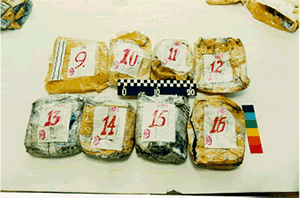 Heroin packets seized in Yekatrinburg in July 2002 |
Historically, couriers smuggled small amounts of heroin into Russia for distribution, either by swallowing or hand-carried in their luggage. However, recent bulk seizures confirm statements of Russian authorities, who have informed DEA Moscow that heroin stockpiles are now being stored in Russia, rather than in Central Asia. This trend may have been fueled by the ease of cross-border smuggling and increased heroin demand in Russia. Heroin shipments appear to be broken down in “storage depots” in southern Russian cities and repackaged for further transit, either towards Moscow or the RFE. One such channel exists from Irkustsk to Yekatrinburg to Moscow, along the trans-Siberian railroad. Since roads in this area are often dilapidated or non-existent, air and rail are the most common methods used to ship goods.
Local media state that Central Asian heroin smugglers are aware that security is lax along the Russia-Kazakhstan border, and they often brag that they can pass through the border without documentation for their cargo. It is not a difficult task to avoid Russian border guards on the flat steppes, where posts are often from 100 to 300 kilometers apart. According to the head of the Russian Federal Border Service, it would cost Russia 17 billion rubles (approximately US$542 million) to fix border security problems with Kazakhstan.
Smugglers do not find it difficult to skip customs altogether, even if they cross the border legally. After 1991, when new customs checkpoints were established in newly independent Russia, they were placed in nearby border cities, rather than on the actual border, as a convenience to customs employees. Therefore, customs inspections often do not occur until many kilometers inside the actual border, creating a comfortable buffer zone for the smuggler between the border and customs inspections. The risk of interdiction is also low for train couriers because tightened train schedules force customs officials to make only cursory checks. For example, the train that passes between Petropavel, Kazakhstan, and Isilkul, Russia, runs several times a day. Russian Customs officials are permitted only 10 minutes to check the documents and goods held by shuttle traders before the train heads back into Kazakhstan. This is insufficient time for Russian Customs officials to search for concealed drugs.In February 2003, Russia, Belarus, Ukraine, and Kazakhstan began talks to form the “Union of Four,” a single economic zone designed to promote the free movement of labor, capital, and goods. Although this union will likely stimulate trade, it may further impede drug enforcement efforts by customs officials and police.
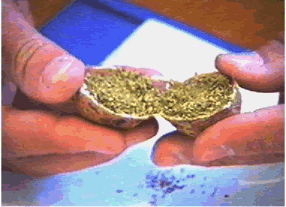 Drugs concealed in walnut shell |
THE TRAFFICKERS
Weak borders and an increased demand for heroin in Russia provide the impetus for many poverty-stricken people from Central Asia to participate in the drug trade. Tajik traffickers have taken over some of the areas previously controlled by Nigerians, Azeris, and Chechens. Although these groups are still prevalent in western Russia, Tajiks have grown to control most of eastern Russia’s market. One Russian account states that Nigerian dealers must now buy their heroin from Tajiks, rather than from West African importers. Tajiks are engaging Russian gangs over the heroin market, sometimes violently. Russian law enforcement authorities have found it difficult to penetrate these Tajik groups with informants or undercover agents, because they are based on clan and tribal ties. Even worse, sometimes Tajik groups hold a courier’s family members hostage, threatening to kill them if the courier talks to police after an arrest.
Although significant amounts of heroin are still smuggled to Russia by air courier, most heroin is driven into Russia by truck or in train cargo. Tajik and Uzbek traffickers exploit the legitimate fruit and vegetable trade between Russia and Central Asia by concealing heroin in food shipments. One trafficker told a Russian newspaper that a truck hauling 20 tons of fruit can hide 200 kilograms of heroin. A typical operation includes several families, usually from one clan, who collaborate to ship goods to Russia. Drivers are hired, and clan representatives accompany them. Smugglers are paid between US$300 and US$400, and given round-trip tickets if they are traveling by rail or air. The smugglers require careful negotiating skills, since Russian and Kazakh law enforcement officials regularly stop vehicles driven by Central Asians. The trafficker also stated that low-level officers can generally be bribed to allow suspect cargo to pass through, while higher ranking officers are less susceptible. However, if a trafficker is caught by any officer with drugs in-hand, it is unlikely he could buy his way out of the situation.
Chinese Traffickers
Although the majority of opiates are trafficked across the Kazakh border, the 3,645-kilometer border between China and Russia is also significant. Chinese traffickers distribute synthetic stimulants and some opiates, and typically will cross into the RFE’s Maritime, Amur, and Jewish Autonomous Districts disguised as shuttle traders. Although Russia estimates that 61 percent of ephedrine smugglers are ethnic Russians returning from China, there is a large body of evidence that Chinese citizens, some of whom are associated with large international Chinese triads, are involved in cross-border smuggling.
Korean Traffickers
While Central Asians are RFE’s primary heroin traffickers, both the U.S. and Russian authorities suspect that North Korean traffickers have been smuggling opiates and synthetic stimulants into the RFE for years. Russian analysts believe that, in the mid-1990s, North Koreans shifted their focus to methamphetamine production to offset heroin revenues lost when their opium poppy crops dwindled, and when Central Asians began taking over the eastern market. The Ministry of Internal Affairs (MVD) blames North Korean traffickers for the increasing rates of opiate and methamphetamine abuse in the RFE.
North Korean traffickers operating in the RFE typically consist of seasonal workers in the Russian timber, agricultural, and maritime industries. The Federal Migration Service stated that in 2001, over 2,000 North Korean workers passed into the Vladivostok area. There is also ample evidence that North Korean diplomats engage in trafficking. In 2000, there were at least five reported incidents of North Korean officials smuggling opium and heroin into the RFE. However, there is little evidence to indicate that the Korean Government ordered them to act as drug couriers.
INTERNATIONAL COOPERATION
Russian law enforcement authorities have taken a number of steps to address the drug problem in Siberia and the RFE. Russia cooperates with the Governments of Central Asia, as well as South Korea, Japan, China, and the United States, on international investigations. In one case, a 2-year investigation between Russian Customs, the Federal Security Service (FSB), and their Japanese counterparts resulted in the arrest of a Russian sailor in Abasiri, Japan. Five Russian couriers were detained and more than 19 kilograms of opium were seized. Unfortunately, significant cooperation between investigators in Russia and Kazakhstan is still lacking, largely due to Russia’s mistrust of their Central Asian colleagues.
Russian law enforcement authorities have long associated drug trafficking with terrorism. Following the September 11, 2001, terrorist attacks in the United States, the Russian MVD stepped up their annual Operation Anti-Terror, which targets drug-related criminals in eastern Siberia. The success of this operation led to another successful Operation Anti-Terror in September 2002. According to the Russian media, 985 crimes, mostly drug-related, were investigated and 30 kilograms of drugs were seized.
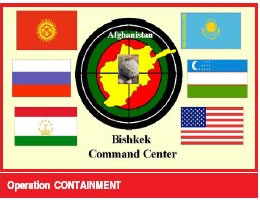 In
September 2002, the DEA and the U.S. Department of State signed a Letter
of Agreement with Russia to establish the Southern Borders Project (SBP).
The SBP will create and equip interagency task forces in Orenburg, Chelyabinsk,
and Omsk, three significant heroin trafficking bottlenecks along Siberia’s
southern border. While inter-agency task forces and mobile enforcement
teams are commonplace in U.S. drug enforcement, Russia has practically
no experience managing groups comprised of different agencies. The DEA
hopes that the success of the SBP will lead to the creation of similar
task forces in the cities of Astrakhan, Novorossiysk, and St. Petersburg.
In
September 2002, the DEA and the U.S. Department of State signed a Letter
of Agreement with Russia to establish the Southern Borders Project (SBP).
The SBP will create and equip interagency task forces in Orenburg, Chelyabinsk,
and Omsk, three significant heroin trafficking bottlenecks along Siberia’s
southern border. While inter-agency task forces and mobile enforcement
teams are commonplace in U.S. drug enforcement, Russia has practically
no experience managing groups comprised of different agencies. The DEA
hopes that the success of the SBP will lead to the creation of similar
task forces in the cities of Astrakhan, Novorossiysk, and St. Petersburg.
During the June-July 2002 interdiction blitz under Operation Containment, SECI and the DEA Moscow Country Office established the Bishkek Command Center (BCC) in Kyrgyzstan as a regional tactical and analytical center. The BCC was comprised of law enforcement representatives from Russia, Kazakhstan, Kyrgyzstan, Tajikistan, and Uzbekistan. Although the BCC was operational for only the duration of the blitz, these countries successfully worked together in conducting joint operations. It is hoped that a new regional intelligence-sharing center will be located in Central Asia based on the BCC’s successes.
AN UNCERTAIN FUTURE
Although the problems facing Siberia and the RFE are presently domestic issues for the Russian Government, the impact on Russia’s neighbors could be substantial if organized crime and Central Asian heroin traffickers continue to proliferate. The Russian Government has already taken steps to address the issues of crime and poverty in Russia’s federal districts. In 2002, President Putin brought more national attention to drugs, turning the war on drugs into a fight against terrorism and for Russia’s future. As a sign of his determination, he signed an edict in March 2003 that consolidates the efforts of over 30 federal agencies, which have a counterdrug emphasis, into one agency. The Russian State Committee for the Control of Narcotic Drugs and Psychotropic Substances (Goskomnark, or GKPN) will be staffed with 40,000 employees, and will operate as an independent ministry, rather than under the Ministry of Internal Affairs. The GKPN was formally established in July 2003, and will absorb the 7,300 staff members of the former Drug Control Department.
Through Operation CONTAINMENT and the upcoming SBP, the DEA will continue to work closely with Russia’s law enforcement agencies to engage traffickers smuggling in Afghan heroin. However, much more remains to be done. Central Asian traffickers have already demonstrated their skill in moving large amounts of drugs into eastern Russia, while ROC groups have shown clear control of Russian ports. Since ROC permits the distribution of heroin in areas they control within Russia, it would take little imagination, and only a few more entrepreneurial steps, for them to start exporting heroin from Russia’s eastern ports to markets in Japan, South Korea, and the United States. At present, there is no concrete evidence linking Russia’s Pacific ports to large-scale drug traffic to the United States. This situation may radically change as economic relations and commercial trade between the United States and Russia strengthens.
1 Pacific Rim countries, South Korea, Japan, China, Taiwan, Malaysia,
Indonesia, the Philippines, and Australia, border the Pacific Ocean
and share significant trade and commercial ties.
2 SECI member countries are Albania, Bosnia and Herzegovena,
Bulgaria, Croatia, Former Yugoslav Republic of Macedonia, Greece, Hungary,
Moldova, Romania, Slovenia, and Turkey. Other Western European countries
and the United States are represented as observers.
3 By comparison, the United States has an area of 9,629,091
square kilometers and a population of nearly 281 million, or 29.1 people
per square kilometer.
4 Although
the official number of registered addicts in Russia is approximately
300,000, experts believe that the unofficial number is 10 times higher.
| This report was prepared by the Europe, Asia, Africa Strategic Intelligence Unit, Regional Strategic Intelligence Section, Office of Strategic Intelligence. This report reflects information received prior to April 2003. Comments and requests for copies are welcome and may be faxed to the Intelligence Production Unit, Intelligence Division, DEA Headquarters, at (202) 307-8726. |
DEA-03053